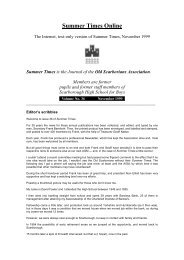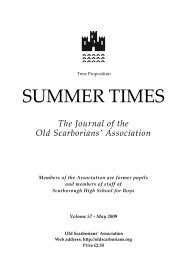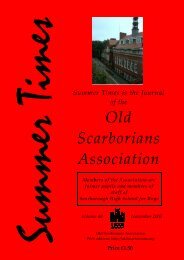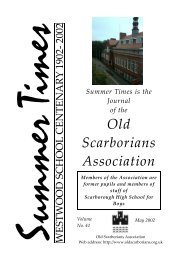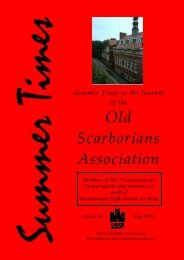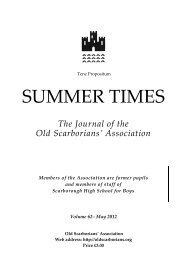Summer Times is the Journal of the Old Scarborians Association
Summer Times is the Journal of the Old Scarborians Association
Summer Times is the Journal of the Old Scarborians Association
Create successful ePaper yourself
Turn your PDF publications into a flip-book with our unique Google optimized e-Paper software.
played for an Oxford University team against<br />
some <strong>of</strong> <strong>the</strong> major public schools. At Radley,<br />
for instance, I remember <strong>the</strong>re were four large<br />
cricket fields, with pitches good enough for<br />
test matches. At Wellington, <strong>the</strong>re were about<br />
20 nets. All we had was <strong>the</strong> ra<strong>the</strong>r rough track<br />
perched atop Oliver’s Mount and <strong>the</strong> even<br />
rougher net wicket cut in <strong>the</strong> coarse grass <strong>of</strong><br />
<strong>the</strong> outfield.<br />
Consider, too, <strong>the</strong> standard <strong>of</strong> coaching. True,<br />
we had dedicated masters such as Rossington,<br />
Stoddard, Hovington, Roxburgh and Haigh,<br />
who gave unstintingly <strong>of</strong> <strong>the</strong>ir time, umpiring<br />
and giving up <strong>the</strong>ir Saturdays to take us to<br />
away matches. However, I do not remember<br />
being coached by any <strong>of</strong> <strong>the</strong>m. Indeed, when<br />
<strong>the</strong>re were no practice facilities worthy <strong>of</strong> <strong>the</strong><br />
name it would have been impossible, so we<br />
had to look elsewhere.<br />
Eric Dixon’s experience makes <strong>the</strong> point. Like<br />
me, he went to <strong>the</strong> nets at <strong>the</strong> Scarborough<br />
Club ground every night <strong>of</strong> <strong>the</strong> season. On<br />
one occasion, former Yorkshire and England<br />
player Wilf Barber was v<strong>is</strong>iting <strong>the</strong> Club and<br />
someone suggested that Eric should have a go<br />
at keeping in <strong>the</strong> nets to <strong>the</strong> bowling <strong>of</strong> Bill<br />
Foord. And, <strong>of</strong> course, <strong>the</strong> lack <strong>of</strong> space meant<br />
he had to stand up to <strong>the</strong> wicket to take Bill’s<br />
considerable pace.<br />
On <strong>the</strong> strength <strong>of</strong> th<strong>is</strong> performance alone<br />
Barber, who was <strong>the</strong>n employed by <strong>the</strong> North<br />
Riding County Council Education Committee,<br />
invited Eric to play for h<strong>is</strong> youth team against<br />
<strong>the</strong> West Riding. Up to th<strong>is</strong> time, Eric had<br />
been playing for <strong>the</strong> school Under 14 team,<br />
plus a few games with <strong>the</strong> 2 nd XI. Only now<br />
that he had been recogn<strong>is</strong>ed outside <strong>the</strong><br />
school was he chosen for <strong>the</strong> school 1 st XI to<br />
give him some experience before <strong>the</strong> big<br />
match.<br />
Three o<strong>the</strong>r SBHS players were chosen for<br />
Barber’s side: Hume, Newton and Horswood,<br />
Hume as captain. Dixon remembers that<br />
Brian Close was playing for <strong>the</strong> West Riding.<br />
He also remembers that Horswood opened<br />
<strong>the</strong> bowling and, in h<strong>is</strong> first over, bowled<br />
31<br />
three or four beamers (dangerous head‐high<br />
full ‐ tosses), which gave r<strong>is</strong>e to some hostile<br />
mutterings among <strong>the</strong> spectators. As he and<br />
Eric crossed at <strong>the</strong> end <strong>of</strong> <strong>the</strong> over <strong>the</strong> embar‐<br />
rassed bowler explained that he had never<br />
had a new ball in h<strong>is</strong> hand before and that it<br />
just kept slipping out.<br />
Even <strong>the</strong> once‐ or twice‐a‐season sessions on<br />
Oliver’s Mount with Wilf Barber and h<strong>is</strong> suc‐<br />
cessor Maurice Leyland, which started after<br />
1945, provided little benefit on <strong>the</strong>ir fleeting<br />
v<strong>is</strong>its<br />
These deficiencies could account for some <strong>of</strong><br />
<strong>the</strong> aston<strong>is</strong>hingly low scores recorded, par‐<br />
ticularly during <strong>the</strong> war years. In 1943, for<br />
instance, <strong>the</strong> School tied with Leeds Training<br />
College with a score <strong>of</strong> 28, <strong>the</strong> batting aver‐<br />
ages were topped by Boddy (8.4) and Ge<strong>of</strong>f<br />
Denn<strong>is</strong> topped <strong>the</strong> bowling averages with just<br />
4.3. In <strong>the</strong> Colts, Horswood’s bowling average<br />
<strong>of</strong> 2.5 got him only second place to Tindall at<br />
2.48. Again, in a match in 1945, Vokes took 6<br />
for 6 against Bridlington.<br />
By contrast, about 500 feet down from <strong>the</strong><br />
Oliver’s Mount field, Scarborough College<br />
had a lovely flat ground about 25 yards from<br />
<strong>the</strong> back door <strong>of</strong> <strong>the</strong> school building, and at<br />
different times <strong>the</strong>y had Wilf Barber and <strong>the</strong>n<br />
Percy Holmes, ano<strong>the</strong>r former Yorkshire and<br />
England player, as full‐time coaches. The<br />
benefits were made clear when <strong>the</strong> College’s<br />
Brian Moor metamorphosed from gawky no‐<br />
hoper into a batsman with one <strong>of</strong> <strong>the</strong> loveliest<br />
swings you could ever w<strong>is</strong>h to see send a<br />
cricket ball rippling over <strong>the</strong> grass for four.<br />
What compensated for our school’s shortcom‐<br />
ings was <strong>the</strong> Scarborough Cricket Club, which<br />
had good nets and a succession <strong>of</strong> pr<strong>of</strong>ession‐<br />
als to look after <strong>the</strong> coaching. And what also<br />
must have helped was <strong>the</strong> fact that we were<br />
able to watch and emulate <strong>the</strong> first class and<br />
very good club cricketers who played <strong>the</strong>re.<br />
So although we did have a succession <strong>of</strong> very<br />
good players, it <strong>is</strong> probably fair to say that<br />
<strong>the</strong>y emerged almost in spite <strong>of</strong> <strong>the</strong> school.






